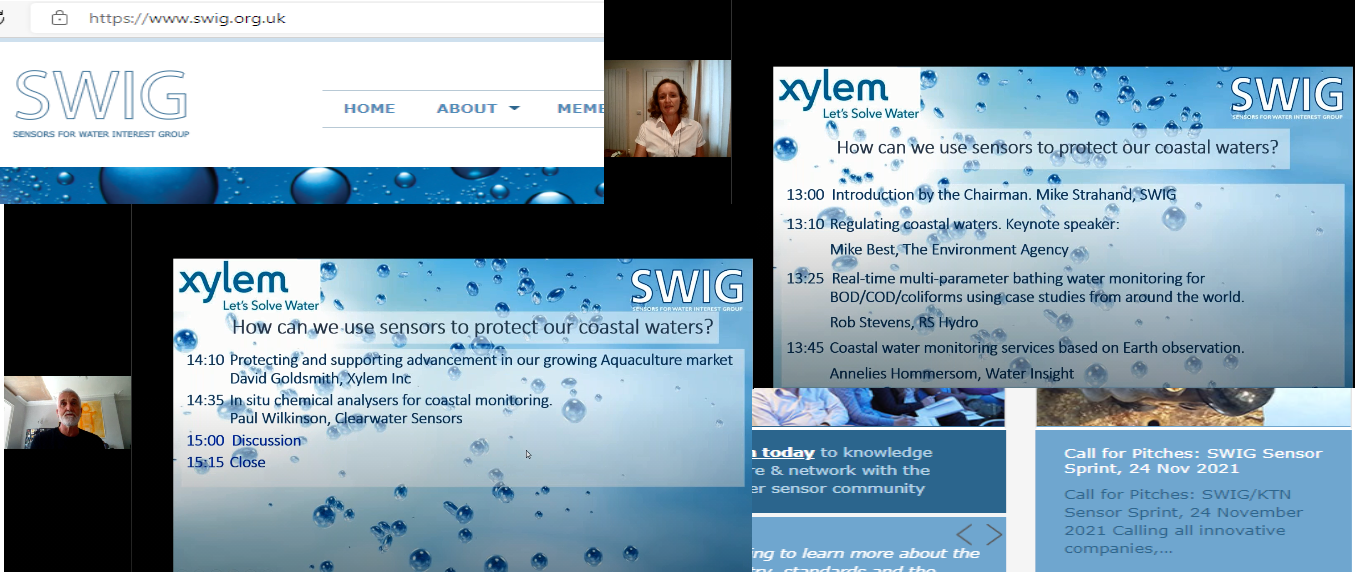‘How can sensors protect our coastal waters?’ – Webinar Overview’
Hosted by Sensors for Water Interest Group (SWIG), the twenty-year-old non-for-profit UK water management industry information, ideas-exchange, and networking group, the half-day ‘How can sensors protect our coastal waters’ Webinar held on July 14th 2021 took Naghmeh Kamali and Mike Griew from MTU on a whistle-stop tour of state-of-the-art coastal water quality monitoring.
After SWIG Programme Manager Rosa Richards opened the Webinar, Mike Strahand, also of SWIG and chairing the event, introduced speakers whose topics were themed around trends in water quality sensor innovation and innovation gaps being filled by the latest generation devices. These issues directly overlap work on the ‘SmartPump’ marine biotoxin sampling system under development for STREAM, so our attendees eagerly awaited the presentations.
Keynote speaker, Mike Best from the UK Environment Agency, kicked off the session by describing challenges faced by water regulators dealing not only with outstanding pollution monitoring issues on limited budgets, but also facing new and ever-more pressing requirements for monitoring in the light of climate change. Mike also explained that the trend for increased frequency and resolution of data at low costs (the STREAM paradigm) made possible by sensor innovation should go hand-in-hand with appropriate filtering and contextualization of data. Data released for public consumption prematurely can be misinterpreted even to the extent that costly court battles and hefty fines ensure, so negating potential benefits of dense data sets.
Rob Steven, from Proteus Instruments, then provided examples of in-situ real-time water quality monitoring programs from around the world, including one study in Cardiff Bay, ‘home turf’ for our Welsh STREAM colleagues.
Annelies Hommersom, representing ‘Water Insight’, directed attention upwards by describing Earth Observation sensor techniques applicable to water quality monitoring and explaining how remote sensing data complements and supports terrestrial data, and how state-of-the-art satellite sensing allied with AI data analysis provides fine-grained temporal and spatial data of interest to environmental scientists. She also introduced the H2020 funded CoastObs project (coastobs.eu) that aims to build a platform to provide commercial coastal water monitoring services based on earth observations.
David Goldsmith from Xylem, the event’s sponsors, took the floor next to talk about the sensor technology behind intense but sustainable and competitive aquaculture innovation – another particularly STREAM-relevant topic. David described applications ranging from the latest algae farming project, aiming to produce human and animal food products and plastic replacement compounds as well as help mitigate climate change through oxygen production and CO2 absorption, to ultra-energy-efficient shrimp farm processing in Austria so effective that costs match imports from traditional Asian markets.
Alex Beaton from Clearwater Sensors wrapped up the session with a fascinating review of the “lab-on-a-chip” sensor technology introduced in their latest generation products. Microfluidic technology and nano-engineering solutions (like those under development for STREAM) not only deliver similar accuracy and reliability as traditional lab analysis but thanks to simple deployment and low power budgets, provide higher frequency data at a lower cost.
Rosa closed the Webinar with the welcome news that SWIG intends to host a video library stocked with training and promotional material provided by water quality monitoring industry stakeholders on their website (swig.org.uk). This resource should prove invaluable for STREAM collaborators and project followers alike. With an offer to broker networking amongst delegates arriving shortly afterwards, SWIG certainly provided our delegates with a value-for-money event.


